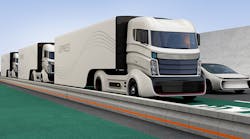Earlier this year, the International Transport Forum (ITF) published a report on global action and legal issues pertaining to the transition to driverless trucks. While technology and innovation move at a swift pace, indeed regulatory and infrastructure changes will lag a few years behind.
We may still be a long way away from a future where trucks and ships will be controlled by artificial intelligence (AI) alone. But even so, preparing for a future that is more reliant upon autonomous vehicles should remain a priority for corporations that employ vast fleets across multiple geographic regions. Failure to plan for this eventual inevitability would be a mistake for players in the logistics industry.
Some trials have already taken place, such as the 120-mile driverless “beer run” that Anheuser-Busch did in 2016 between Fort Collins and Colorado Springs, Colo. However, Lior Ron, co-founder of self-driving truck company Otto, which powered the ride, said that for the foreseeable future AI technologies would merely act as a “co-pilot” to a truck driver.
DHL is due to start testing several autonomous delivery vehicles, including the DHL StreetScooter, in 2018, thanks to cooperation with NVIDIA and ZF, one of the world’s largest automotive suppliers. There are many advantages to this technology, both for companies and for the drivers themselves. For starters, we expect autonomous trucks to be much more energy-efficient, and thus both cost-efficient and beneficial for the environment—an important factor for a company like DHL, which has set itself the goal of reaching zero emissions by 2050.
Then there is the job itself. Trucking is hard work—drivers, in particular on long-haul lanes, work long hours and need complete focus at all times. As it is, there is already quite a labor shortage in markets such as the U.S. and the U.K.
According to industry website truckinginfo.com, in 2016 in the U.S. alone, there was a shortage of around 50,000 drivers, with projections showing the need for an additional 100,000 drivers for 2017, as the workforce is aging. Truckinginfo.com says the average age of a truck driver is 49, and many of them are now retiring. In part this is due to the fact that the job, especially for the long-haul trucking part of the market, is difficult. Drivers are away from home for long stretches of time and often more attractive work beckons elsewhere.
The Real Benefits for Drivers
It is directly related to these areas where I see the real benefits for drivers. Autonomous technology will for sure assist drivers. Advances in technology will also bring additional safety—drivers still have to be alert, but with areas such as speed, acceleration and breaking controlled by automation with zero reaction time, road safety is significantly increased.
Think of airplane pilots. While some of the takeoff and landing tasks are performed autonomously by computers, the skill and expertise of the pilot is still very much required. The technology works alongside the human crew rather than replacing them. And for a long time to come, this will be how autonomous truck driving will operate.
In addition, I foresee a future where we will be able to connect two or more trucks through the use of vehicle-to-vehicle communications technology, to form a so-called “truck train” or platoon, able to operate as a single unit. This technology has the potential of enabling the industry to become safer and much more efficient as a single driver, aided by AI, will be able to comfortably haul several truckloads.
DHL is currently involved in a British government-funded platooning research project, led by transport consulting firm TRL, to trial the use of this form of communications technology in the U.K. using real-world logistics scenarios. In this project, drivers will be present in all vehicles with the lead driver controlling acceleration and braking for all vehicles, while drivers of the following vehicles will retain steering control for their vehicles and be ready to take control if required.
The U.K. trials will provide stakeholders with the evidence to enable them to better assess the long-term effects of platooning technology on road safety, the economy, the environment and traffic congestion.
Otto’s Ron expects driverless trucks to be cruising on U.S. freeways in the coming decade. He may be right; however, given the challenges both in terms of technology and regulation even with passenger vehicles at this stage, the fully autonomous future for trucking could also be further away.
I agree with the ITF that governments must look far into the future and consider ways to manage the transition to driverless trucks, to avoid potential social disruption from job losses. It is just as important, though, for our industry to begin considering a future where autonomous trucking is the way forward. Machine learning technology will likely never totally supplant drivers within our industry, but it should help improve their performance and if leveraged properly, it has the potential to make their jobs easier and safer.
Bill Meahl is chief commercial officer of global logistics company DHL, where he is responsible for coordinating the cross-commercial activities of the DHL divisions Express, Global Forwarding, Freight, Parcel, Supply Chain and e-Commerce. He is a member of DHL’s executive committee and previously served as chief operating officer of DHL Supply Chain (DSC), a provider of contract logistics. Prior to that he was CEO of DHL Exel Supply Chain Americas.



